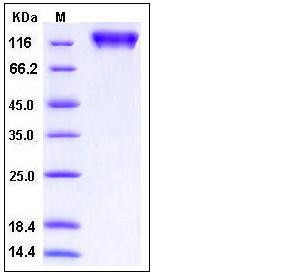Human MERTK / Mer Protein (His & Fc Tag)
c-Eyk,c-mer,MER,RP38,Tyro12
- 100ug (NPP4078) Please inquiry
| Catalog Number | P10298-H03H |
|---|---|
| Organism Species | Human |
| Host | Human Cells |
| Synonyms | c-Eyk,c-mer,MER,RP38,Tyro12 |
| Molecular Weight | The recombinant human Mer/Fc is a disulfide-linked homodimeric protein. The reduced monomer consists of 726 amino acids and predicts a molecular mass of 80 kDa. By SDS-PAGE, the apparent molecular mass of rh Mer/Fc monomer is approximately 140-150 kDa due to the glycosylation. |
| predicted N | Ala 21 |
| SDS-PAGE |  |
| Purity | > 97 % as determined by SDS-PAGE |
| Protein Construction | A DNA sequence encoding the extracellular domain (Met 1-Ala 499) of human Mer precursor (NP_006334.2) was fused with the polyhistidine-tagged Fc region of human IgG1 at the C-terminus. |
| Bio-activity | |
| Research Area | Signaling |Signal Transduction |Jak/STAT Signaling |Receptors in the Jak/STAT Pathway |
| Formulation | Lyophilized from sterile PBS, pH 7.4 1. Normally 5 % - 8 % trehalose, mannitol and 0.01% Tween80 are added as protectants before lyophilization. Specific concentrations are included in the hardcopy of COA. |
| Background | &Proto-oncogene tyrosine-protein kinase MER (MERTK) is a member of the MER/AXL/TYRO3 receptor kinase family and encodes a transmembrane protein with two fibronectin type-III domains, two Ig-like C2-type (immunoglobulin-like) domains, and one tyrosine kinase domain. MERTK is localized in membrane and is no expressed in normal B- and T-lymphocytes but is expressed in numerous neoplastic B- and T-cell lines. This protein is highly expressed in testis, ovary, prostate, lung, and kidney, with lower expression in spleen, small intestine, colon, and liver. MERTK regulates many physiological processes including cell survival, migration, differentiation, and phagocytosis of apoptotic cells (efferocytosis). Ligand binding at the cell surface induces autophosphorylation of MERTK on its intracellular domain that provides docking sites for downstream signaling molecules. MERTK signaling plays a role in various processes such as macrophage clearance of apoptotic cells, platelet aggregation, cytoskeleton reorganization and engulfment. MERTK plays also an important role in inhibition of Toll-like receptors (TLRs)-mediated innate immune response by activating STAT1, which selectively induces production of suppressors of cytokine signaling SOCS1 and SOCS3. Defects in MERTK are the cause of retinitis pigmentosa type 38. |
| Reference |
